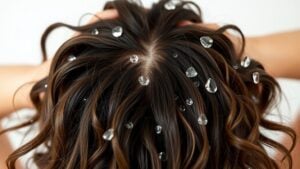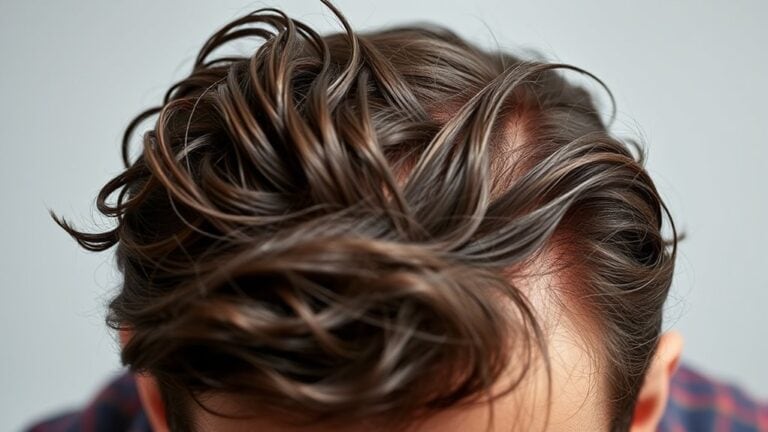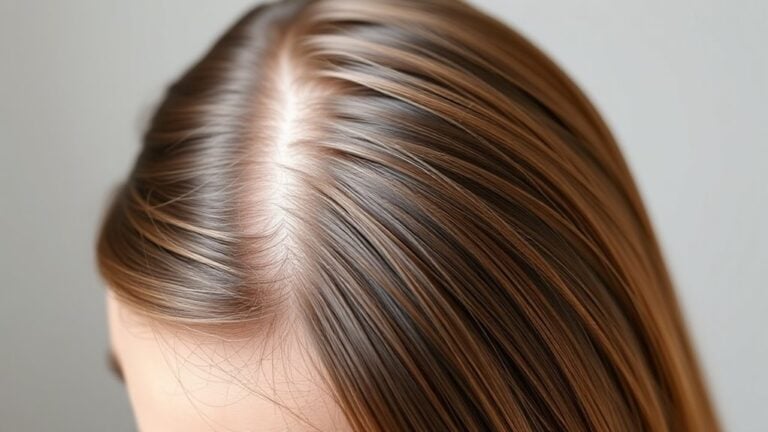Reverse hair washing flips the usual routine through applying conditioner before shampoo, aiming to give both scalp and strands a healthier reset. This method tackles buildup and dryness differently, allowing the conditioner to soften hair initially while the shampoo clears away oils and debris without stripping moisture. It’s not for everyone—fine or oily hair could love the lift, while dry scalps may find relief. The trick lies in timing and product choices, but executed properly, it can transform limp or irritated hair into something fresher and fuller. Curious how it works? The details may surprise you.
The Science Behind Reverse Hair Washing
Reverse hair washing flips the traditional routine—instead of applying conditioner initially, followed by shampoo. This method commences with conditioner to hydrate strands before shampooing, which gently removes excess product without stripping moisture. The process encourages hair follicle stimulation through allowing the scalp to breathe, as shampoo clears away buildup that could block follicles.
Scalp exfoliation happens naturally as the shampoo lifts away dead skin cells and residue left behind by conditioner. Unlike traditional washing, this approach prevents heavy products from weighing hair down, leaving it lighter and more voluminous. The science behind it lies in balancing hydration and cleansing—conditioner preps the hair, while shampoo guarantees the scalp stays clean. This method suits those seeking softer hair without greasiness or irritation.
How Reverse Hair Washing Benefits Your Scalp
Many people struggle with a dry, itchy scalp or buildup that leaves hair feeling heavy and greasy. Reverse hair washing helps by concentrating on scalp exfoliation to begin with, gently removing dead skin and product residue before conditioning. This method prevents clogged follicles, allowing the scalp to breathe and absorb moisture better.
Why Your Hair Type Matters for Reverse Washing
Hair porosity levels and scalp oil production play a big role in how well reverse washing works for different people. Some hair types absorb products quickly, while others struggle to retain moisture, affecting the results.
Comprehending these factors helps customize the method for improved results.
Hair Porosity Levels
Comprehending how well hair absorbs and holds moisture starts with porosity levels, which play a significant role in whether reverse washing functions for an individual. Hair porosity types—low, medium, and high—determine how easily products penetrate the hair shaft. Those with low porosity struggle with product absorption, while high porosity hair loses moisture quickly. Testing porosity helps tailor routines for better results.
Hair porosity testing: Float a clean strand in water—sinking fast means high porosity, slow means low.
Low porosity: Cuticles are tight, resisting moisture; lightweight products work best.
Medium porosity: Balanced absorption and retention, ideal for most routines.
High porosity: Gaps in cuticles cause dryness; richer products help seal moisture.
Reverse washing benefits: Conditioner-first can prep low-porosity hair or prevent high-porosity hair from over-absorbing cleansers.
Understanding porosity guarantees reverse washing aligns with hair needs.
Scalp Oil Production
Since scalp oil production varies from individual to individual, it plays a crucial role in determining whether reverse washing will function effectively. Those with inherently oily scalps may profit most, as the method assists harmonize sebum production by eliminating excess oil without stripping the scalp completely.
On the other hand, people with dry scalps might discover reverse washing too harsh, disrupting their already delicate healthy scalp environment. Fine hair tends to get greasy faster, rendering reverse washing a sensible choice, while thick or curly hair, which often lacks natural moisture, could end up drier.
Comprehending one’s hair type and oil levels guarantees the technique enhances rather than harms. A well-moisturized scalp stays comfortable, avoiding irritation or flakiness, so tailoring the approach matters.
Step-by-Step Guide to Reverse Hair Washing
Many people find traditional hair washing leaves their locks feeling dry or weighed down, but flipping the routine can make a big difference. Reverse hair washing starts with conditioning initial, then cleansing, which helps balance the scalp purification process while keeping strands soft.
Here’s how to try this hair cleansing technique:
- Apply conditioner to damp hair, focusing on mid-lengths to ends, avoiding the scalp.
- Rinse thoroughly with lukewarm water to prevent buildup.
- Follow with shampoo, massaging gently into the roots to remove excess oil and product.
- Rinse again, ensuring no residue remains.
- Finish with cool water to seal the hair cuticle for shine.
This method keeps the scalp clean without stripping moisture, making it ideal for dry or damaged hair.
Common Mistakes to Avoid When Reverse Washing
Reverse hair washing can work marvels, but a few slip-ups could leave hair greasy, tangled, or even drier than before. Overexfoliation risks arise whenever scrubbing the scalp too aggressively, stripping natural oils and causing irritation. Improper technique implementation, like applying conditioner before fully rinsing out shampoo, leads to buildup or limp strands. To prevent these pitfalls, follow these key guidelines:
| Mistake | Solution |
|---|---|
| Over-scrubbing scalp | Use gentle circular motions |
| Skipping shampoo rinse | Rinse thoroughly before conditioning |
| Using heavy products | Opt for lightweight formulas |
Timing matters—leave conditioner on long enough to hydrate but not so long it weighs hair down. Adjust water temperature; lukewarm prevents dryness. Patience guarantees the method works as intended.
Best Products for Reverse Hair Washing
Choosing the proper products makes all the distinction as soon as flipping the traditional hair-washing routine. The right selections support scalp health while preventing buildup or dryness. For effective reverse hair washing, these product recommendations fit seamlessly into hair care routines:
- Lightweight conditioner: Opt for silicone-free formulas to avoid weighing hair down before cleansing.
- Gentle clarifying shampoo: Removes residue without stripping moisture, ideal for the second step.
- Scalp serum: Hydrates and soothes whether the process feels drying.
- Wide-tooth comb: Distributes conditioner evenly before rinsing.
- Leave-in spray: Adds lightweight hydration post-wash for frizz control.
Focusing on balanced ingredients guarantees the method boosts hair texture without irritation. Steer clear of heavy oils or thick creams, as they might interfere with cleansing. The goal is simplicity—products that complement, not complicate, the routine.
How Often Should You Reverse Wash Your Hair?
The frequency of reverse washing depends on hair type, texture, and how much product buildup occurs. Fine or oily hair can benefit from this method two to three times a week, while thicker or drier hair might require it just once weekly. Those using heavy styling products could necessitate more frequent reverse washing to prevent residue.
The ideal frequency balances scalp health without stripping natural oils. A suitable schedule adjusts based on how hair feels—greasy roots or weighed-down strands signal it’s time. Overdoing it can lead to dryness, so paying attention to hair’s response is key. Experimenting helps find the right rhythm, ensuring both scalp and strands stay clean and nourished without unnecessary stress.
Comparing Reverse Washing to Traditional Hair Washing Methods
Reverse washing flips the traditional method through applying conditioner initially, followed by shampoo, altering how products interact with hair. This approach changes the cleansing process, potentially reducing buildup while keeping hair moisturized compared to standard washing.
The order of application could also influence scalp health and hair texture differently than conventional routines.
Cleansing Method Differences
Many people don’t realize how much the order of washing hair affects its health and appearance. Traditional washing starts with shampoo, stripping natural oils, while reverse washing begins with conditioner, protecting strands before cleansing. The differences lie in how each method handles product buildup, moisture retention, and hair type differences.
Traditional washing can leave hair dry, especially for curly or coarse textures, as shampoo removes oils initially. Reverse washing reduces frizz by coating hair with conditioner before shampoo, ideal for thick or damaged hair. Fine hair may feel weighed down with reverse washing if too much conditioner is used.
Product buildup is less likely with reverse washing since shampoo rinses away conditioner residue. Scalp health improves with reverse washing, as shampoo still cleanses but without over-drying.
Choosing the right method depends on hair needs and concerns.
Product Application Order
One key difference between reverse and traditional hair washing comes down to the moment products touch the strands. Traditional washing begins with shampoo, stripping oils before conditioning. Reverse washing flips the product application sequence, applying conditioner first to protect hair, then shampooing to cleanse without over-drying.
This product layering order shifts focus—traditional methods prioritize cleansing, while reverse washing shields strands before cleaning. The approach changes how ingredients interact; conditioner acts as a barrier, reducing shampoo’s harsh effects. Traditional steps can leave hair brittle in case of over-washing, whereas reverse washing balances moisture and cleanliness.
The method suits those with dry or damaged hair, as the altered sequence prevents stripping natural oils. Both routines work, but the order determines how hair responds to each product’s effects.
Scalp and Hair Impact
The way hair and scalp react to washing methods depends on how products interact with them. Reverse washing—conditioning first, then shampooing—differs from traditional methods in key ways.
- Scalp hydration benefits: Reverse washing prevents over-drying, as shampoo removes excess conditioner without stripping natural oils.
- Hair regrowth stimulation: A cleaner scalp promotes healthier follicles, potentially aiding growth.
- Reduced product buildup: Washing last ensures no residue weighs hair down.
- Improved volume: Traditional washing can leave hair flat, while reverse washing lifts roots.
- Balanced moisture: Unlike traditional methods, reverse washing avoids greasiness while keeping strands soft.
This approach suits those with fine or oily hair, while traditional washing may better serve very dry scalps. The choice hinges on individual needs and hair type.
Conclusion
Reverse hair washing isn’t just a trend—it’s a hair revolution. Through flipping the script on traditional washing, it transforms limp locks into cascading waterfalls of volume and turns flaky scalps into serene, oil-balanced gardens. This method doesn’t just clean; it resurrects hair from the brink of dullness, making every strand a testament to brilliance. For those tired of bad hair days, reverse washing isn’t an option—it’s the only salvation.





